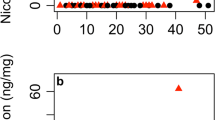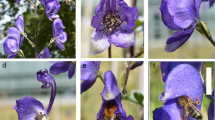Abstract
The morphological and chemical characteristics of flowers which attract pollinators present a dilemma for plants; advertising may increase the “apparency” of plants to their predators and some pollinators are also predators. We explore how a self-compatible disturbance species,Nicotiana attenuata, copes with this potential dilemma by examining the changes in emission of chemicals from flowers in response to pollination and herbivory. We propose that chemical changes induced by herbivory and pollination reflect the function of the chemicals in the plant. The emission of a single compound, benzyl acetone (BA, 4-phenyl-2-butanone), by flowers increases dramatically (50x) in the evening, peaking just after dark —a pattern of emission characteristic of moth-pollinated flowers. Pools of BA were found only in the outer lip of the corolla where pollinators come in contact with the flower, and diurnal changes in the size of the corolla pool closely paralleled the amount emitted by intact flowers throughout the day, as determined by headspace sampling. Pollination dramatically decreases both the pools of BA in the corolla and its emission from flowers. Similarly, nicotine, a broadly biocidal defense metabolite and an induced defense in vegetative and reproductive tissues, is also found in the headspace of flowers and is principally localized in the basal parts of the corolla below the attachment of the filaments and the nectar reward. Moreover, the dynamics of the corolla pools of BA and nicotine throughout the day are consistent with their roles in advertisement and defense, respectively. The corolla pools of nicotine are stable throughout the day except during the period of peak BA production and emission when nicotine pools decrease significantly. The coordinated increase in BA emission and decline in nicotine pools are not inexorably linked, because herbivory or mechanical damage to corolla tissue rapidly increases corolla nicotine pools without affecting the increase in BA pools. Similarly, leaf damage results in a slower, systemic increase in corolla nicotine pools during reproductive growth but again does not affect BA pools. Excised flowers emitted BA in a manner similar to that of intact flowers, and excision of a majority of flowers from a plant did not alter the BA emission patterns of the remaining flowers. We conclude that althoughN. attenuata's defensive and advertisement chemistries respond synchronously to some environmental stimuli, the flowers' chemical responses to pollinators and herbivoresare distinct and the differences reflect their ecological roles. We propose that the cost-benefit framework of the optimal defense and apparency theories can be fruitfully applied to the allocation of defense metabolites and floral volatiles that function in pollinator attraction, and that this framework can be readily tested by manipulating the patterns of the emissions of plants in the field.
Similar content being viewed by others
References
Baldwin IT (1989) The mechanism of damaged-induced alkaloids in wild tobacco. J Chem Ecol 15: 1661–1680
Baldwin IT (1991) Damage-induced alkaloids in wild tobacco. In: Tallamy DW, Raupp MJ (eds) Phytochemical induction by herbivores. Wiley, New York, pp 47–69
Baldwin IT (1994) Chemical changes rapidly induced by folivory. In: Bernays EA (ed) Insect-plant interactions, vol 5. CRC, Boca Raton, pp 1–23
Baldwin IT, Karb MJ (1995) Plasticity in the allocation of nicotine to reproductive parts inNicotiana attenuata. J Chem Ecol 21: 897–909
Baldwin IT, Morse L (1994) Up in smoke. II. Germination ofNicotiana attenuata in response to smoke-derived cues and nutrients in burned and unburned soils. J Chem Ecology 20: 2373–2391
Baldwin IT, Ohnmeiss TE (1993) Alkaloidal responses to damage inNicotiana native to North America. J Chem Ecol 19: 1143–1153
Baldwin IT, Karb MJ, Ohnmeiss, TE (1994a) Allocation of15N from nitrate to nicotine: production and turnover of a damage-induced mobile defense. Ecology 75: 1703–1713
Baldwin IT, Staszak-Kozinski L, Davidson R (1994b) Up in smoke. I. Smoke derived germination cues for postfire annual,Nicotiana attenuata Torr. ex Watson. J Chem Ecol 20: 2345–2371
Berenbaum M, Seigler D (1992) Biochemicals: engineering problems for natural selection. In: Roitberg BD, Isman MB (eds) Insect chemical ecology. Chapman and Hall, New York, pp 89–121
Boodley JW, Sheldrake R (1977) Cornell peat mixes for commercial plant growing. (Information bulletin no. 43). Cornell University, Ithaka
Chew FS, Courtney SP (1991) Plant apparency and evolutionary escape from insect herbivory. Am Nat 138(3): 729–750
Dicke M, Sabelis MW (1989) Does it pay plants to advertize for bodyguards? Toward a cost-benefit analysis of induced synomone production. In: Lambers H, Cambridge ML, Konings H, Pons TL (eds) Causes and consequences of variation in growth rate and productivity of higher plants. SPB Academic, The Hague, pp 341–358
Dicke M (1994) Local and systemic production of volatile herbivore induced terpenoids: their role in plant carnivore mutualisms. J Plant Physiol 143: 465–472
Dobson HEM (1994) Floral volatiles in insect biology. In: Bernays EA (ed) Insect-plant interactions, vol 5. CRC, Boca Raton, pp 47–81
Drukker B, Scutareanu P, Sabelis MW (1995) Do anthocorid predators respond to synomones fromPsylla-infested pear trees under field conditions? Entomol Exp App 77: 193–203
Flath RA, Ohinata K (1982) Votatile components of the orchidDendrobium superbum Rchb. f. J Agric Food Chem 30: 841–842
Feeny PP (1976) Plant apparency and chemical defense. In: Wallace JW, Mansell RL (eds) Biochemical interaction between plants and insects (Recent advances in phytochemistry, vol 10). Plenum, New York, pp 1–40
Galen C, Newport MEA (1988) Pollination quality, seed set, and flower traits inPolemonium viscosum: complementary effects of variation in flower scent and size. Am J Bot 75: 900–905
Goodspeed TH (1954) The genusNicotiana. Chronica Botanica, Waltham
Heath RR, Landolt PJ, Dueben B, Lenczewski B (1992) Identification of floral compounds of night blooming jessamine attractive to cabbage looper moths. Environ Entomol 21: 854–859
Heftmann E, Schwimmer S (1972) Degradation of tomatine to 3ß-hydroxy-5∂-pregn-16-en-one by ripe tomatoes. Phytochem 11: 2783–2787
Jakobsen HB, Olsen CE (1994) Influence of climatic factors on emission of flower volatiles in situ. Planta 192: 365–371
Knudsen JT, Tollsten L (1993) Trends in floral scent chemistry in pollination syndromes: floral scent composition in moth pollinated taxa. Bot J Linn Soc 113: 263–284
Krischik VA, Denno RF (1983) Individual, population, and geographic patterns in plant defense. In: Denno RF, McClure MS (eds) Variable plants and herbivores in natural and managed systems. Academic Press, New York, pp 463–512
Loughrin JH, Hamilton-Kemp TR, Anderson RA, Hildebrand DF (1990) Volatiles from flowers ofNicotiana sylvestris, N. otophora andMalusx domestica: headspace components and day/night changes in their relative concentrations. Phytochemistry 29: 2473–2477
Loughrin JH, Hamilton-Kemp TR, Anderson RA, Hildebrand DF (1991) Circadian rhythm of volatile emission from flowers ofNicotiana sylvestris andN. suaveolens. Physiol Plant 83: 492–496
Loughrin JH, Hamilton-Kemp TR, Burton HR, Anderson RA, Hildebrand DF (1992) Glycosidically bound volatile components ofNicotiana sylvestris andN. suaveolens flowers. Phytochemistry 31: 1537–1540
McKey D (1974) Adaptive patterns in alkaloid physiology. Am Nat 108: 305–320
Metcalf RL, Metcalf ER (1991) Plant kairomones in insect biology and control. Chapman and Hall, New York
Morgan AC, Lyon SC (1928) Notes on amyl salicylate as an attractant to the tobacco hornworm moth. J Econ Entomol 21: 189–191
Ohnmeiss TE, Baldwin IT (1994) The allometry of nitrogen allocation to growth and an inducible defense under nitrogen-limited growth. Ecology 75: 995–1002
Pearce G, Ryan CA, Liljegren D (1988) Proteinase inhibitors I and II in fruit of wild tomato species: transient components of a mechanism for defense and seed dispersal. Planta 175: 527–531
Pellmyr O, Thien LB (1986) Insect reproduction and floral fragrances: keys to the evolution of the angiosperms. Taxon 35: 76–85
Pellmyr O, Tang W, Groth I, Bergström C, Thien LB (1991) Cycad cone and angiosperm floral volatiles: inferences for the evolution of insect pollination. Biochem Syst Ecol 19: 623–627
Rhoades DF, Cates RG (1976) Toward a general theory of plant antiherbivore chemistry. In: Wallace JW, Mansell RL (eds) Biochemical interaction between plants and insects (Recent advances in phytochemistry vol 10). Plenum, New York, pp 168–213
Rodriguez E, Levin DA (1976) Biochemical parallelism of repellents and attractants in higher plants and arthropods. In: Wallace JW, Mansell RL (eds) Biochemical interaction between plants and insects (Recent advances in phytochemistry vol 10). Plenum, New York, pp 214–270
Schmeltz I (1971) Nicotine and other tobacco alkaloids. In: Jacobson M, Crosby DG (eds) Naturally occurring insecticides. Marcel Dekker, New York, pp 99–136
Tallamy DW, Raupp MJ (1991) Phytochemical induction by herbivores. Wiley, New York
Tollsten L, Bergström J (1989) Variation and post-pollination changes in floral odors released byPlantathera bifolia (Orchidaceae). Nord J Bot 9: 359–362
Tumlinson JH, Lewis WJ, Vet LEM (1993) How parasitic wasps find their hosts. Sci Am 46–52
Wells PV (1959) An ecological investigation of two desert tobaccos. Ecology 40: 626–644
Williams NH (1982) The biology of orchids and euglossine bees. In: Ardittis J (ed) Orchid biology: perspectives and reviews, II. Cornell University Press, Ithaca, pp 119–172
Zangerl AR, Bazzaz FA (1992) Theory and pattern in plant defense allocation. In: Fritz RS, Simms EL (eds) Plant resistance to herbivores and pathogens: ecology, evolution and genetics. University of Chicago Press, Chicago, pp 363–391
Author information
Authors and Affiliations
Rights and permissions
About this article
Cite this article
Euler, M., Baldwin, I.T. The chemistry of defense and apparency in the corollas ofNicotiana attenuata . Oecologia 107, 102–112 (1996). https://doi.org/10.1007/BF00582240
Received:
Accepted:
Issue Date:
DOI: https://doi.org/10.1007/BF00582240




